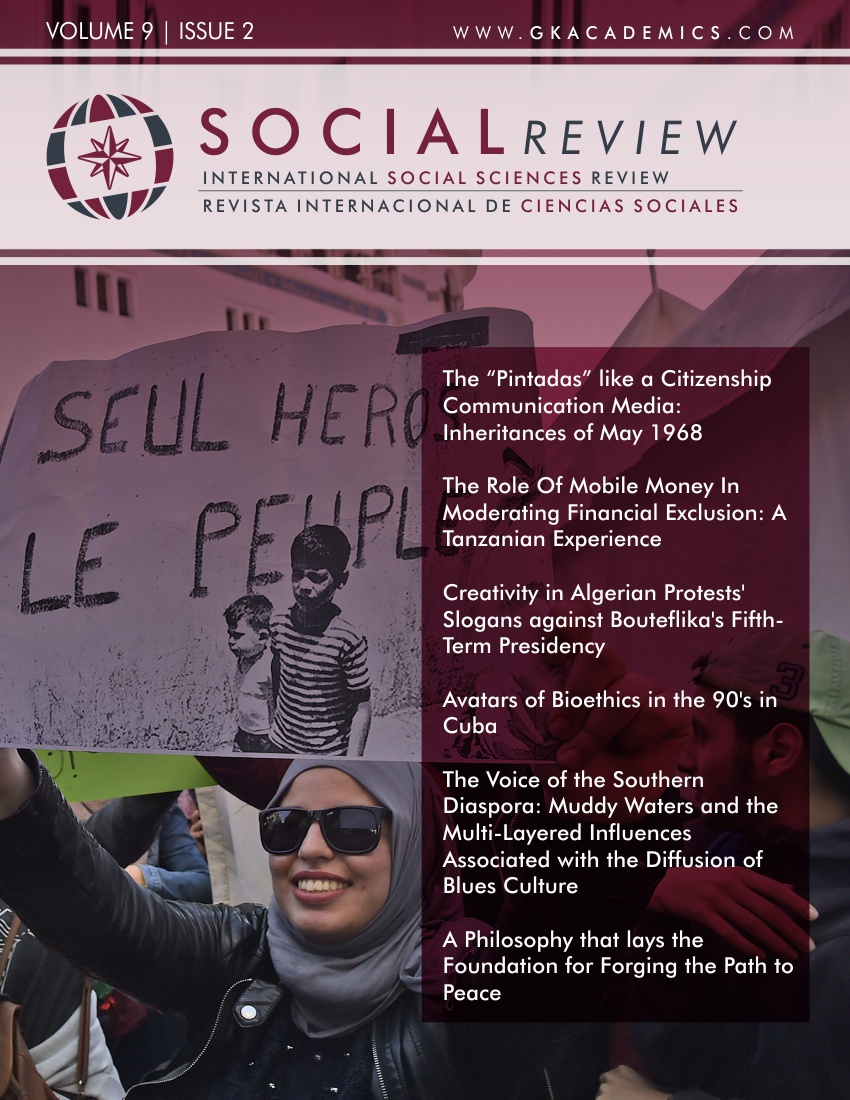The “Pintadas” like a Citizenship Communication Media: Inheritances of May 1968
DOI:
https://doi.org/10.37467/gka-revsocial.v9.2518Keywords:
Graffiti, Citizen Communication, Visual Sociology, Social ChangeAbstract
Half a century after May 1968 in France, graffiti in public space is still a current civic expression. This is the origin of the research “The pintadas like a citizenship communication media” whose objective is to explore and inventory messages with political and social content, initially in Bogotá and then transcend to other geographies. Starting from visual sociology, a robust photographic material has been registered. As a result, the categories of education and resistance stand out as the most prominent, where signatories and anonymous seem to remember that rebellious culture of Paris.
Downloads
Global Statistics ℹ️
|
531
Views
|
89
Downloads
|
|
620
Total
|
|
References
Alvarado, S. y Chaves, J. I. (2018). Las pintadas: comunicación ciudadana plasmada en las paredes del espacio público bogotano. En: K. Gherab Martín, K. y Luna, Á. (eds.), Entornos Humanos y sociales, una aproximación multidisciplinar (pp. 233-247). Madrid: Global Knowledge Academics. Recuperado de https://es.calameo.com/books/00509824918a8ee31b570
Angulo, M. (2006). Inscripciones, pintadas y graffitis en calles y servicios: literatura efímera, ideología del pueblo. Culturas Populares Revista Electrónica, 2. Recuperado de https://ebuah.uah.es/dspace/handle/10017/19421
Badenes, P. (2008). Affiches y pintadas: "la verdadera" revolución del mayo francés del 68. Dossiers Feministes, 12, 121-136. Recuperado de https://www.raco.cat/index.php/DossiersFeministes/article/view/140711
Barzuna, G. (2005). Graffiti: la voz ante el silencio. Revista Letras, 37, 129-138. https://www.revistas.una.ac.cr/index.php/letras/article/view/4061
Canales, J. A. (2011). La Memoria Canalla de Bogotá. Ciudades (Im)propias: la tensión entre lo global y lo local. Ciudades globales, espacios locales. Valencia: UPV. 233-240. Recuperado de http://www.upv.es/entidades/CIAE/info/Libro_IIcongreso.pdf
Chacón, J.C. y Cuesta, O.J. (2013). El grafiti como expresión artística que construye lo político: pluralidad de mundos y percepciones. Una mirada en Bogotá. Revista nodo, 14 (7), 65-76. Recuperado de https://dialnet.unirioja.es/servlet/articulo?codigo=4323702
Chaplin, E. (2005). Sociology and visual representation. New York: Routledge.
Chaves, J.I. (26 noviembre 2018). EducAcción. Nueva Tribuna. Recuperado de https://www.nuevatribuna.es/articulo/america-latina/educaccion-educacion-accion-universidad-americalatina/20181126113443157867.html
Chaves, J.I. (10 mayo 2018). Seamos realistas, sigamos pidiendo lo imposible. Nueva Tribuna. Recuperado de https://www.nuevatribuna.es/articulo/mundo/mayo68-mayofrances-nochebarricadas-revolucion-paris/20180510090155151734.html
Chaves, J.I. (27 abril 2018). Comuna 13 [entrada en blog]. Pateras al Sur. Recuperado de https://paterasalsur.wordpress.com/2018/04/27/comuna-13/
Cooper, M. & Chalfant, H. (1984). Subway art. London: Thames & Hudson Ltd.
De Miguel, J. (2003). El ojo sociológico. REIS Revista española de investigaciones sociológicas, (101), 49-88. DOI: https://doi.org/10.2307/40184451
Diccionario de la lengua española (2018). Recuperado de https://dle.rae.es/
Freund, G. (2015). La fotografía como documento social. Barcelona: Editorial Gustavo Gili.
Gama, M. y León, F. (2016). Bogotá arte urbano o graffiti. Entre la ilegalidad y la forma artística de expresión. Revista Arte, Individuo y Sociedad, 28(2), 355-369. Recuperado de https://revistas.ucm.es/index.php/ARIS/article/view/49933 DOI: https://doi.org/10.5209/rev_ARIS.2016.v28.n2.49933
Gómez-Abarca, J. (2014). Graffiti: una expresión político-cultural juvenil en San Cristóbal de Las Casas, Chiapas, México. Revista Latinoamericana de Ciencias Sociales, Niñez y Juventud, 12 (2), 675-689. Recuperado de http://www.redalyc.org/pdf/773/77331488011.pdf
Harper, D. (2012). Visual Sociology. New York: Routledge. DOI: https://doi.org/10.4324/9780203872673
Herrera, M. y Olaya, V. (2011). Ciudades tatuadas: arte callejero, política y memorias visuales. Revista Nómadas, 35, 98-116. Recuperado de http://nomadas.ucentral.edu.co/index.php/inicio/14-regimenes-de-visualidad-emancipacion-y-otredad-desde-america-latina-nomadas-35/140-ciudades-tatuadas-arte-callejero-politica-y-memorias-visuales
Hurtado, D. (2010). Los jóvenes de Medellín: ¿Ciudadanos apáticos? Revista Nómadas, 32, 99-115. http://www.redalyc.org/pdf/1051/105114733007.pdf
Laburu, A. (2015). Graffitis. Sanción, condena penal o manifestación artística. RIIPAC: Revista sobre Patrimonio Cultural, 5-6, 295-300. Recuperado de https://dialnet.unirioja.es/servlet/articulo?codigo=5188985
Licona, E. y González, D. (2007). El graffiti como tatuaje urbano. Graffylia: Revista de la Facultad de Filosofía y Letras, 7, 103-106.
López, J. A. (2011). El documental de los años sesenta como arte: consideraciones de la película Crónica de un verano. Palabra Clave, 14 (2), 235-246. Recuperado de https://palabraclave.unisabana.edu.co/index.php/palabraclave/article/view/1975/2533 DOI: https://doi.org/10.5294/pacla.2011.14.2.3
Marzal, J. (2016). Cómo se lee una fotografía. Interpretaciones de la mirada. Madrid: Ediciones Cátedra (Grupo Anaya S.A.).
Bateson, G. & Mead, M. (1993). Balinese Character: A photographic analysis. New York Academy of Sciences.
Ortega, M. (2009). Metodología de la sociología visual y su correlato etnológico. Argumentos 22 (59), 165-184. Recuperado de http://ref.scielo.org/y4hy8t
Redacción Judicial (18 enero 2017). Caso grafitero: Muerte de Diego Felipe Becerra "no fue un accidente". El Espectador. Recuperado de http://www.elespectador.com/noticias/judicial/caso-grafitero-muerte-de-diego-felipe-becerra-no-fue-un-articulo-675441
Sánchez-Prieto, J.M. (2001). La historia imposible del mayo francés. Revista de estudios políticos, (112), 109-133. Recuperado de https://dialnet.unirioja.es/servlet/articulo?codigo=27654
Silva, A. (2006). Imaginarios urbanos. Bogotá: Arango Editores Ltda.
Vigara, A. M. y Reyes, P. (1996). Graffiti y pintadas en Madrid: arte, lenguaje, comunicación. Espéculo, (4). Recuperado de http://www.ucm.es/info/especulo/numero4/graffiti.htm
Vivero, L. (2012). Murales y graffiti: expresiones simbólicas de la lucha de clases. Ánfora, 19 (33), 71- 87. Universidad Autónoma de Manizales. Recuperado de http://www.redalyc.org/pdf/3578/357834267004.pdf DOI: https://doi.org/10.30854/anf.v19.n33.2012.70
Downloads
Published
How to Cite
Issue
Section
License
Those authors who publish in this journal accept the following terms:
-
Authors retain copyright.
-
Authors transfer to the journal the right of first publication. The journal also owns the publishing rights.
-
All published contents are governed by an Attribution-NoDerivatives 4.0 International License.
Access the informative version and legal text of the license. By virtue of this, third parties are allowed to use what is published as long as they mention the authorship of the work and the first publication in this journal. If you transform the material, you may not distribute the modified work. -
Authors may make other independent and additional contractual arrangements for non-exclusive distribution of the version of the article published in this journal (e.g., inclusion in an institutional repository or publication in a book) as long as they clearly indicate that the work was first published in this journal.
- Authors are allowed and recommended to publish their work on the Internet (for example on institutional and personal websites), following the publication of, and referencing the journal, as this could lead to constructive exchanges and a more extensive and quick circulation of published works (see The Effect of Open Access).













